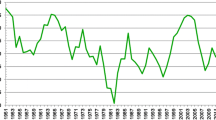Abstract
This paper shows that plant and firm size in manufacturing, and especially in engineering industry, in several Western industrial countries has declined since the early 1970s. Two hypotheses explaining the decline are advanced. One is “de-glomeration” or specialization: the divestiture of non-core businesses in order to free up scarce resources (particularly management time) to defend and nurture core business activities. The second hypothesis is that the emergence of new computer-based technology has improved the quality and productivity of small and medium scale production relative to standardized mass-production techniques which dominated previously.
Similar content being viewed by others
References
Acs, Zoltan J. and David B. Audretsch, 1987, ‘Innovation, Market Structure, and Firm Size,’ Review of Economics and Statistics 69 (November), 567–575.
Acs, Zoltan J. and David B. Audretsch, 1988, ‘Employment Generation and Firm Size in the U.S. and West Germany’, Discussion Paper, Wissenschaftszentrum Berlin.
Acs, Zoltan J., David B. Audretsch, and Bo Carlsson, 1988, ‘Flexible Technology and Firm Size’, RPIE Working Paper, Case Western Reserve University.
Altshuler, Alan, et al., 1984, The Future of the Automobile. The Report of MIT's International Automobile Program, Cambridge, MA: The MIT Press.
Birch, David L., 1981, ‘Who Creates Jobs?,’ The Public Interest 65 (Fall), 3–14.
Carlsson, Bo, 1984, ‘The Development and Use of Machine Tools in Historical Perspective,’ Journal of Economic Behavior and Organization 5, 91–114.
Carlsson, Bo, 1987, ‘Flexible Manufacturing and U.S. Trade Performance’, Case Western Reserve University, Research Program in Industrial Economics (RPIE) Working Paper.
Carlsson, Bo, 1988, ‘Flexibility and the Theory of the Firm’, Case Western Reserve University, Research Program in Industrial Economics Working Paper, forthcoming in the International Journal of Industrial Organization.
Carlsson, Bo, Erik Dahmen, Anders Grufman, Märtha Josefsson, and Johan Örtengren, 1979, Teknik och Industristruktur — 70-talets ekonomiska kris i historisk belysning (Technology and Industrial Structure — the Economic Crisis of the 70s in Historical Perspective), Stockholm: Industrial Institute for Economic and Social Research (IUI) and Royal Swedish Academy of Engineering Sciences (IVA).
Duché, Genevieve and Suzane Savey, 1987, ‘The Rising Importance of Small and Medium-Sized Firms: Towards a New Industrial System?’, in F. E. I. Hamilton (ed.), Industrial Change in Advanced Economies, London: Croom Helm.
Edquist, Charles and Staffan, Jacobsson, 1987, ‘The Diffusion of Industrial Robots in the OECD Countries and the Impact Thereof’, Robotics 3 (March), 23–32.
Edquist, Charles and Staffan Jacobsson, 1988, Flexible Automation. The Global Diffusion of New Technology in the Engineering Industry, London: Basil Blackwell.
Grant, Bruce and Lars-Erik Gadde, 1983, Automotive Component Supply Strategies, Gothenburg: Chalmers University of Technology.
Gudgin, G. 1984, ‘P. M. E. et créations d'emplois. Le cas exemplaire du Royaume-Uni’, in Les P.M.E. créent-elles des emplois? Paris: Economica.
Hicks, Donald A., 1986, Automation Technology and Industrial Renewal. Adjustment Dynamics in the U.S. Metal-working Sector, Washington, D.C.: American Enterprise Institute.
Imai, Ken-ichi, 1987, ‘Network Industrial Organization in Japan’, Paper presented at the International Workshop on New Issues in Industrial Economics, Case Western Reserve University, June.
Leclerc, E., 1984, ‘Modernisation des P.M.I. japonaises et mutations des structures productives’, in Les P.M.E. créent-elles des emplois? Paris: Economica.
Mills, David E. and Laurence Shumann, 1985, ‘Industry Structure with Fluctuating Demand’, American Economic Review 75 (September), 758–767.
Piore, Michael J. and Charles F. Sabel, 1984, The Second Industrial Divide: Possibilities for Prosperity, New York: Basic Books.
Ravenscraft, David J. and F. M. Scherer, 1987, ‘Life after Takeover’, Journal of Industrial Economics XXXVI (December), 147–156.
Rosegger, Gerhard, 1986, ‘International Rivalry and Cooperation: The Case of the U.S. Automobile Industry’, Case Western Reserve University, Research Program in Industrial Economics Working Paper.
Scherer, F. M., 1988, ‘Corporate Takeovers: The Efficiency Arguments’, Journal of Economic Perspectives 2 (Winter), 69–82.
Shepherd, William G., 1982, ‘Causes of Increased Competition in the Economy, 1939–1980’, Review of Economics and Statistics 64, 613–626.
White, Lawrence J., 1982, ‘The Automobile Industry’, in Walter Adams (ed.), The Structure of American Industry, sixth edition. New York: Macmillan Publishing Co., Inc.
Author information
Authors and Affiliations
Rights and permissions
About this article
Cite this article
Carlsson, B. The evolution of manufacturing technology and its impact on industrial structure: An international study. Small Bus Econ 1, 21–37 (1989). https://doi.org/10.1007/BF00389914
Accepted:
Issue Date:
DOI: https://doi.org/10.1007/BF00389914




